Just in case, text SAFE (7233)
Text where you plan to be and how you are getting there to 7233 for FREE so that there’s a record of your plan to be safe.
SAFE text is a way to give you and your loved ones a little peace of mind. We’ll save your SAFE text with the time and date and phone number it was sent from, and if something does happen and the police ask us if we have any information, we can give it to them immediately.
How does SAFE text work?
- What should you include in a SAFE text? Share key details like your current location, where you’re planning to go, and the route you’re planning to take. See the examples of ways you can use SAFE below. We’ll send an automatic text back to let you know we got your SAFE text, and it's safe with us.
- How will you remember? 7233 is SAFE on your phone keyboard. Add 7233 to your contacts now so you can send a FREE text anytime.
- What happens when I send a SAFE text? Rest assured, your texts are not monitored and will only be accessed following a formal request from the police. For each text you send to SAFE, we record the date and time the message was sent, as well as the mobile phone number and the message content.
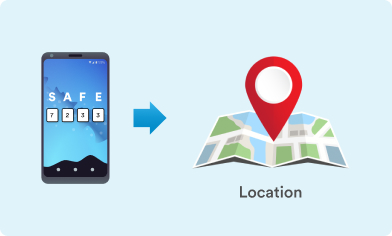
Examples of SAFE texts
- ‘Catching the train to Kingsland from Britomart, then walking home via Sandringham Road. Expect to be home by 9pm.’
- ‘Walking the Mercer Bay Loop Walk with Amy, expect to be back by 3pm’.
- ‘Missed bus. Change of plan. Catching ride from Tauranga to Hamilton with Arjun’s friend Tim, car reg AMS12349. Leaving 10.30am’
- ‘With 3 workmates leaving Mexican restaurant on Church St, Palm Nth at 11pm. Walking to motel 365 Main Street.’
Remember to record the city you’re in as many cities, towns and rural areas may have a ‘main street’ or ‘town centre’.
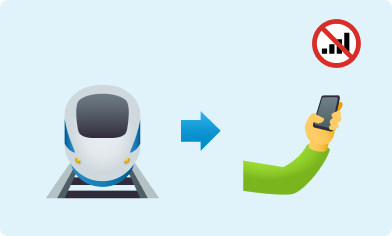
What you need to know about SAFE text
- SAFE text is only a text message, not a picture or video message, so make sure you explain clearly where you are.
- You can send a SAFE Text 24/7 and we’ll automatically confirm we got it.
- If you’re in danger, always call 111 (or the local emergency number if you’re overseas – a quick Google will let you know what it is).
- SAFE text isn't an alternative to calling 111 in an emergency. It is a precautionary way to record where you are in case anything goes wrong.
- If you’re ever worried about getting home, you should always let someone know what your plans are. Tell them where you are going, who you are with, and when you think you’ll be back. That way, someone can let the Police know if you haven’t returned as expected.
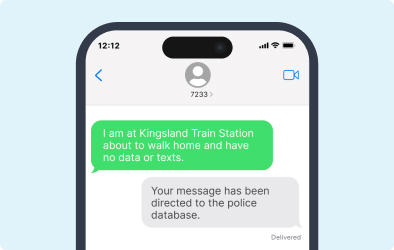
Who can see a SAFE text I’ve sent?
We send your text to the SAFE text database where it will be kept for 12 months. Your text can only be viewed by the Police who might use it as part of their investigation in the unlikely event that you are reported missing. Text messages to SAFE are held in the database for two months. Older messages can be retrieved but may take longer to access.
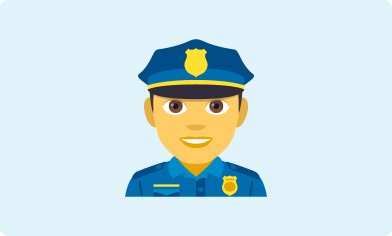
Can I use SAFE text overseas?
Yes, if you’re roaming internationally, you can send a SAFE text from your phone with a 2degrees SIM in. Please keep in mind that you’ll be charged the standard roaming rate of sending a text to 7233 from overseas. It’s also a good idea when you’re in an unfamiliar place to let someone know where you’re going. Tell the front desk staff at your accommodation what your plans are, or let your family know where you plan to be.
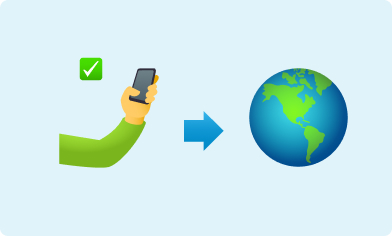
Can I use SAFE text if I’m from overseas and travelling in New Zealand
Yes, please do. Pop a 2degrees SIM in your phone, add SAFE TEXT (7233) to your contacts, and you’re good to go. Before you head out, make sure you also let someone know your plans, like the receptionist at the hotel, or a DOC ranger if you’re going on a hike. Whatever the season is, New Zealand’s weather conditions can change quickly, and part of what makes our country so special is the often variable terrain. It’s important that when you’re exploring the beauty of New Zealand you always make a plan – even if you’re just going on a short day-walk. If you’re planning to spend some time in our great outdoors, be sure to check out the advice from the New Zealand Mountain Safety Council.
